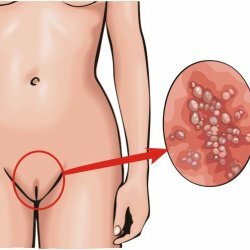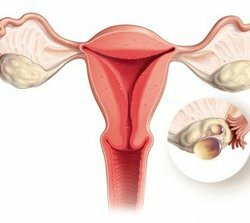Endometrioid heterotopies
Endometriotic heterotopies are endometrial fragments located and functioning outside their normal location, that is, outside the inner layer of the uterus. Endometrioid heterotopias are a sign of endometriosis, a hormone-dependent chronic disease with a genuinely unknown etiology. Due to a whole group of provocative causes, fragments of the mucous layer from the uterine cavity "migrate" to the lower layers of the uterine wall or even other areas, settle down there and begin to function, as if they are still in the uterus, that is, "menstruate."
Functioning endometriotic foci are detected as close to the uterus( fallopian tubes, ovaries, cervix, external genitalia, pelvic peritoneum) and far from it( intestines, urinary organs, lungs and so on).In fact, endometrioid heterotopies can appear anywhere, where there is epithelial tissue, suitable for their "attachment", but more often they are found in the pelvic area.
A bit of anatomy .The uterine wall has a layered structure, and each of the layers forming it fulfills a certain task, therefore it is formed by cells different in structure and function.
Outside the uterus is covered with a leaf of the pelvic peritoneum, transformed into its outer layer - perimeter, a strong serous membrane protecting the genital organ from negative external influences.
The middle uterine layer, myometrium, forms a powerful muscle tissue, capable of stretching and performing intensive contractile movements.
Internal, mucous, layer of the uterus - endometrium. It consists of two unequal layers - basal and functional. The functional layer is regularly updated due to the rejection of "old" cells during menstrual bleeding and recovery from the cells of the basal layer. All the processes occurring in the functional layer depend on the hormonal function of the ovaries.
Endometrioid heterotopies are fragments of the functional layer, so they "work" in a cyclic rhythm - they expand first and then are rejected. It is this behavior of these foci that confirms the hormonal nature of pathology.
Pathology is classified according to topography of heterotopia. If heterotopy occurs only in the muscular wall of the uterus( adenomyosis), isthmus and cervix, endometriosis is classified as internal if the pathological process goes beyond the body - as an external one.
Endometrioid heterotopy is also classified as genital if it is found only in the genital area( eg, endometrioid heterotopia of the cervix), and extragenital if they are far beyond the genital area.
The combination of several forms of heterotopy localization occurs more often than their isolated localization, since the pathological process tends to progress.
What are endometrioid heterotopias
The foci of the endometrioid tissue differ considerably in size and shape: some are similar to point-like round formations, while others grow tens of millimeters in the form of a disorderly accumulation of cells. The appearance of heterotopies in the premenstrual period is typical, when they increase due to the accumulated blood and become darker, and within them one can view the reddish liquid.
Endometrioid heterotopies, regardless of location and size, have the same structure - they form belonging to the functional layer of the endometrium of the cell. According to the phases of the menstrual cycle, heterotopies first grow, and then are rejected, leaving the "wound" site. In fact, the whole process repeats the cyclical changes taking place in the uterus, and even the "small" menstruation, when after bleeding the heterotopia zone bleeds.
Endometrioid tissue has unique properties that allow it to migrate to different distances from the original site, namely:
- it forms foci that are devoid of capsules;
- it is prone to infiltrative growth, so it "creeps" into the underlying tissues and provokes their destruction( destruction);
- it can "travel" with blood, lymph or contact.
Endometrioid heterotopies are more often a mucosal area that is different in appearance and structurally from surrounding tissues. The more rare form is the nodular( with adenomyosis), when the endometrioid tissue grows into the uterine wall in the form of a node resembling a myomatous.
Endometrioid heterotopia of the ovaries initially form point foci, and then more often they are transformed into cysts.
Causes appearance of endometrioid heterotopias
edometrioidnyh heterotopias explain several theories, but the exact mechanism of formation has not been found.
The most likely predisposing factors for the appearance of pathology are:
- Menstruation. It is possible that heterotopias are formed as a result of retrograde casting of endometrial elements beyond the uterus. Most likely this situation, if a woman in the menstrual period excessively loads herself physically.
- Heredity. Genetic predisposition is proved by cases of "family endometriosis", when it is diagnosed in several generations.
- Immune shifts. It is possible that endometrial cells "migrate" in most women, but they do not take root in the "wrong place" thanks to the mechanisms of immune defense. If the immune system is not in order, the formation of heterotopia does not interfere with anything.
- Hormonal dysfunction. In patients with endometriotic heterotopies, hormone shifts are always determined: high concentrations of FSH, prolactin and LH on a background of a decreased level of progesterone. Often they also have an adrogenic dysfunction.
- Metaplasia( transformation) of tissues. Some experts suggest that heterotopies are formed "on the spot", that is, another, for example, mucous neck, transforms into an endometrioid tissue.
- Embryonic disorders, when the differentiation of the tissues of a developing embryo occurs incorrectly.
According to the theories put forward by experts, a list of the most probable causes provoking the appearance of endometrioid heterotopia. The most likely of these include:
- Extensive( often repeated) endometrium damage when its layers between the barrier layer is destroyed cells and elements of the endometrium begin to invade deeper.
- Any diagnostic or therapeutic measures that allow the endometrioid tissue to leave the uterus. For example, an incorrectly performed procedure of cauterization of cervical erosion can provoke endometrioid heterotopia of the cervix.
- Infections, especially chronic. They deplete the immune system and damage the mucous membranes.
Symptoms of endometrioid heterotopies
Often, the presence of endometrioid heterotopies is detected by chance, and they do not provoke any clinic. If
heterotopias have genital localization, there are the following symptoms:
- menstrual dysfunction: mixed on the intensity and duration of bleeding, which can be acyclic;
- pain: pain menstruation begins the day before, become more pronounced when it is offensive and subside together with the end of menstruation.
- premenstrual minor( spotting) discharge.
Endometrioid heterotopias of the ovary often appear on one side, have different sizes and shapes - from a small tubercle on the ovaries to a large cyst.
Heterotopies of extragenital localization do not have a specific clinic. The most typical presence of periodic pain, which are associated with the ingress of blood into surrounding structures after the rejection of endometrioid tissue.
Treatment of endometrioid heterotopies
Endometriosis is not one of the most serious, rapidly progressing ailments. If its manifestations are moderate( or not expressed at all), there is no chance of serious consequences. However, the disease belongs to the category of chronic, so it is difficult to completely cure it.
One of the most unfavorable consequences of pathology is female infertility, so the need to restore reproductive function in young patients determines the tactics and scope of the forthcoming treatment.
Therapy of endometrioid heterotopies depends on the specific clinical situation. Sometimes, if the pathology does not provoke complaints and does not affect fertility, it is enough to eliminate hormonal dysfunction with drugs that restore the proper ratio of estrogens and progestogens( progesterone).Hormonal therapy is selected taking into account individual characteristics, more often used:
- combined preparations( COCs) of monophasic action;
- anti-estrogen preparations of the levonorgestrel type;
- gestagens, including prolonged action( depot - probe);
- androgenic derivatives( Danazol and the like);
- means provoking an "artificial climax" - Zoladek, Buserilin.
Hormone therapy of endometrioid heterotopia is always lengthy. Attention should be paid to the fact that conservative therapy( even the most effective one) is not capable of eliminating heterotopies forever, but with its help it is possible to stop their spread and for a sufficiently long period to stop their functioning and restore the proper hormonal function.
Some forms of pathology, for example, endometrioid heterotopies of the ovaries or retrocervical zone, can not be eliminated only by hormones. In complex situations, especially if heterotopies provoke inflammatory and adhesive processes, there is a need for surgical treatment, which is always combined with hormonal.
The diagnosis of endometrioid heterotopy often frightens patients, but these fears are unreasonable, since severe and complicated forms of the disease are rare, and in the presence of a huge arsenal of medications, the disease can be taken under control.



